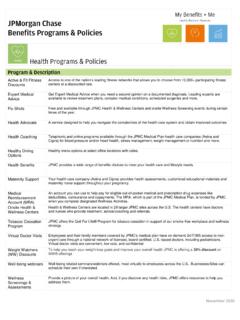Transcription of Engaging Employees in Their Health and Wellness
1 Engaging Employees in Their Health and Wellness well -being is the ability of individuals to address normal stresses, work productively, and realize one s highest Research shows that Employees in good Health are more likely to deliver optimal performance in the ,2,3 Healthy Employees not only have better quality of life, they also benefit from having a lower risk of disease, illness, and injury, as well as increased work productivity and a greater likelihood of contributing to Their communities. Beyond helping workers uphold work-life balance and improve overall Health , organizations are exploring additional Wellness benefits such as recognition, paid time off, leadership training, and community volunteer projects that improve both well -being and overall engagement in the Employee Engagement in Workplace Wellness Wellness program engagement is about more than just showing up at a Health screening or other activity to receive an incentive or avoid a financial penalty.
2 Although participation is necessary to be engaged, Employees do have to be engaged to participate. Engagement involves creating and maintaining a sincere interest and involvement in living a healthy life at home and at work. Workplace Wellness programs are only as effective as the proportion of Employees who are truly engaged in the program. Although industry leaders and researchers vary in Their definition of Wellness program engagement, engagement is commonly viewed as the level of enrollment and sustained participation in a program. This includes: Wellness events ( , walking, nutrition, resilience programs ). Services ( , screening, Health coaching). Resources ( , online assessments, learning modules, training programs ).
3 CDC Workplace Health Resource Center 2 Active participation in these offerings results in Employees making healthy decisions ( , choosing healthy foods, quitting tobacco, exercising regularly, managing stress). Engagement also includes employee input and involvement in the design and execution of the Wellness program. Achieving Wellness Program Engagement According to the Gallup Organization, Companies are most successful at creating a culture of well -being when they provide managers with the right tools for a holistic, multifaceted approach. 4 Organizations can develop a comprehensive culture of Health and well -being for Their Employees . They can not only address individuals Health risk factors, but also organizational factors such as: Relationship to the work environment.
4 Training and leadership. corporate values. They can tailor program offerings to create value for participants and the organization. Surveys on needs and interests, interviews, and focus groups are good ways to understand what is important to Employees . Employers also can learn what kind of rewards, from water bottles to gift cards, might be good incentives for Employees to attend an event or take a survey. They also can gain insight into what might motivate Employees to make changes for a healthier lifestyle. Communication is key to successful employee Organizations can benefit from focus groups that provide information on the best methods and frequency of communication and Increasing program engagement requires different strategies to involve Employees .
5 Consider the following examples of ways to help Employees participate and sustain involvement in workplace Wellness while improving overall 8 CDC Workplace Health Resource Center 3 Ways to Engage Employees in Elements of a Comprehensive Worksite Wellness Program Step 1: Design & Analyze Step 2: Implement Step 3: Evaluate Success Seek and support Employees input and participation in: Creating a Wellness committee. Developing an employee needs and interest survey. Using interviews and focus groups. Completing an employee needs and interests survey. Securing leadership support. Developing a strategic communications plan. Reviewing and designing a benefits plan. Completing a work site Health evaluation.
6 Conducting an organizational policy review. Prioritizing staffing, program materials, data system, recognition, and incentives to develop the budget. Identifying community partners in Health . Identifying measures for program evaluation. Work with Employees to: Create a program accessible to Employees and family members on-site, online, and by phone. Provide programs that are low cost and affordable to the workers. Communicate the program offerings through numerous channels ( , e-mail, posters, website, newsletters, postcards). Create a healthy environment ( , tobacco-free workplace and healthy meeting and vending policies, walking trails, on-site physical activity options). Offer team and individual programming ( , challenges, education sessions).
7 Connect with a Health coach, team leader, or others. Demonstrate leadership support and encouragement in Wellness opportunities. Work with and support managers and senior leaders to: Communicate the benefits of the program and success stories. Provide recognition to individuals and specific units, departments, and locations. Survey participants to capture feedback on programs , including satisfaction and suggestions. Generate participation reports specific to unit, departments, or location. Complete impact measures and reporting to include changes in Health behavior and clinical parameters. Complete cost benefits analysis (requires 2 to 3 years of data). Opportunities and Resources Although the number of employers with well -being programs in the United States is growing, most Employees are unaware of the offerings and associated benefits.
8 There is an opportunity to help Employees connect to company ,5 Reaching out and involving the families too is beneficial for the Health of Employees and Their loved ones. CDC Workplace Health Resource Center 4 Tools and Resources for Engagement in the Wellness Program CDC Worksite Health ScoreCard CDC Work@ Health Program CDC Workplace Health Model Institute for Health and Productivity Studies, Johns Hopkins Bloomberg School of Health Culture of Health , Robert Wood Johnson Foundation National Healthy Worksite Program Case Studies References 1. Centers for Disease Control and Prevention. well -Being Concepts website. Accessed July 19,2018. 2. Harvard Business Review Analytic Services. The Impact of Employee Engagement on Performance.
9 Cambridge, Massachusetts; Accessed July 18, 2018. 3. Institute for Health and Productivity Studies, Johns Hopkins Bloomberg School of Public Health . From Evidence to Practice: Workplace Wellness That Works. Baltimore, Maryland: Johns Hopkins Bloomberg School of Public Health ; 2015. -practice--- Accessed July 18, 2018. 4. Harter J, O Boyle E. Why your workplace Wellness program isn t working. Gallup. 2014]. Accessed July 18, 2018. 5. McCleary K, Goetzel RZ, Roemer EC, Berko J, Kent K, Torre H. Employer and employee opinions about workplace Health promotion ( Wellness ) programs : results of the 2015 Harris Poll Nielsen Survey. J Occup Environ Med. 2017;59(3):256 263. doi: 6. Kelly RK, Carter M. Health and safety: Perspectives from the field.
10 In : MJ Grawitch, DW Ballard (editors). The Psychologically Healthy Workplace: Building a Win -Win Environment for Organizations and Employees . Washington DC: American Psychological Association; 2015. 7. Centers for Disease Control and Prevention, National Institute for Occupational Safety and Health . Essential Elements of Effective Workplace programs . Total Worker Health website. #org. Accessed July 18, 2018. The CDC Workplace Health Resource Center (WHRC) is a one-stop shop for organizations to find credible tools, guides, case studies, and other resources to design, develop, implement, evaluate, and sustain workplace Health promotion programs . Visit the CDC Workplace Health Resource Center to learn more about and strategies for employee engagement.
















